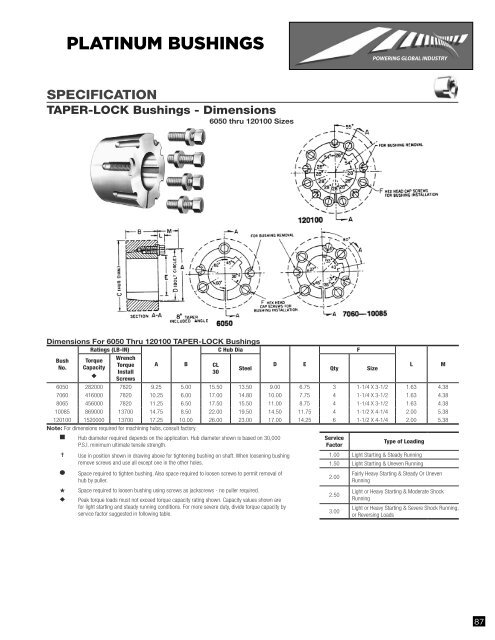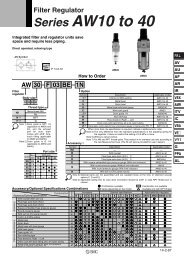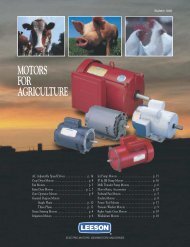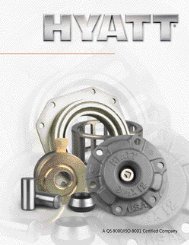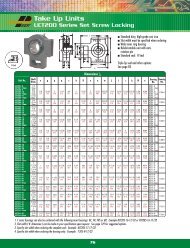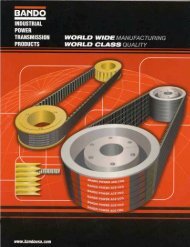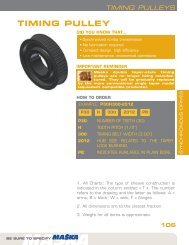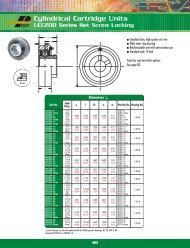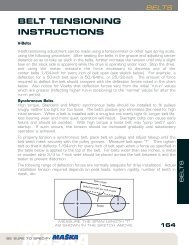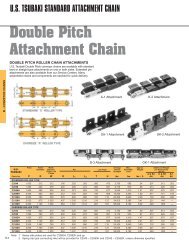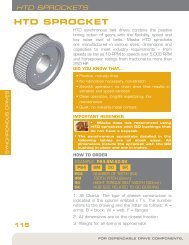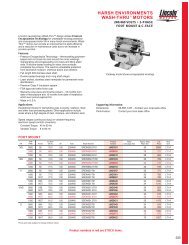Platinum Belt Design Manual - Jason Industrial
Platinum Belt Design Manual - Jason Industrial
Platinum Belt Design Manual - Jason Industrial
Create successful ePaper yourself
Turn your PDF publications into a flip-book with our unique Google optimized e-Paper software.
PLATINUM BUSHINGS<br />
POWERING GLOBAL INDUSTRY<br />
PT Component<br />
Quick References<br />
SPECIFICATION<br />
TAPER-LOCK Bushings - Dimensions<br />
6050 thru 120100 Sizes<br />
Couplings Clutches and Brakes FLEXIDYNE Fluid Couplings TORQUE-TAMER Bushings<br />
Dimensions For 6050 Thru 120100 TAPER-LOCK Bushings<br />
Ratings (LB-IN)<br />
C Hub Dia<br />
Bush<br />
No.<br />
Torque<br />
Capacity<br />
<br />
Wrench<br />
Torque<br />
Install<br />
Screws<br />
A<br />
B<br />
CL<br />
30<br />
D E<br />
Steel Qty Size<br />
6050 282000 7820 9.25 5.00 15.50 13.50 9.00 6.75 3 1-1/4 X 3-1/2 1.63 4.38<br />
7060 416000 7820 10.25 6.00 17.00 14.80 10.00 7.75 4 1-1/4 X 3-1/2 1.63 4.38<br />
8065 456000 7820 11.25 6.50 17.50 15.50 11.00 8.75 4 1-1/4 X 3-1/2 1.63 4.38<br />
10085 869000 13700 14.75 8.50 22.00 19.50 14.50 11.75 4 1-1/2 X 4-1/4 2.00 5.38<br />
120100 1520000 13700 17.25 10.00 26.00 23.00 17.00 14.25 6 1-1/2 X 4-1/4 2.00 5.38<br />
Note: For dimensions required for machining hubs, consult factory.<br />
Hub diameter required depends on the application. Hub diameter shown is based on 30,000<br />
P.S.I. minimum ultimate tensile strength.<br />
✝<br />
<br />
★<br />
<br />
Use in position shown in drawing above for tightening bushing on shaft. When loosening bushing<br />
remove screws and use all except one in the other holes.<br />
Space required to tighten bushing. Also space required to loosen screws to permit removal of<br />
hub by puller.<br />
Space required to loosen bushing using screws as jackscrews - no puller required.<br />
Peak torque loads must not exceed torque capacity rating shown. Capacity values shown are<br />
for light starting and steady running conditions. For more severe duty, divide torque capacity by<br />
service factor suggested in following table.<br />
F<br />
Service<br />
Factor<br />
Type of Loading<br />
1.00 Light Starting & Steady Running<br />
1.50 Light Starting & Uneven Running<br />
2.00<br />
Fairly Heavy Starting & Steady Or Uneven<br />
Running<br />
2.50<br />
3.00<br />
Light or Heavy Starting & Moderate Shock<br />
Running<br />
Light or Heavy Starting & Severe Shock Running,<br />
or Reversing Loads<br />
L<br />
M<br />
T-L FEATURES/BENEFITS<br />
PAGE PT6-2<br />
T-L SPECIFICATION<br />
PAGE PT6-3<br />
QD BUSHINGS<br />
PAGE PT6-17<br />
GT BUSHINGS<br />
PAGE PT6-29<br />
PT6-4<br />
87


